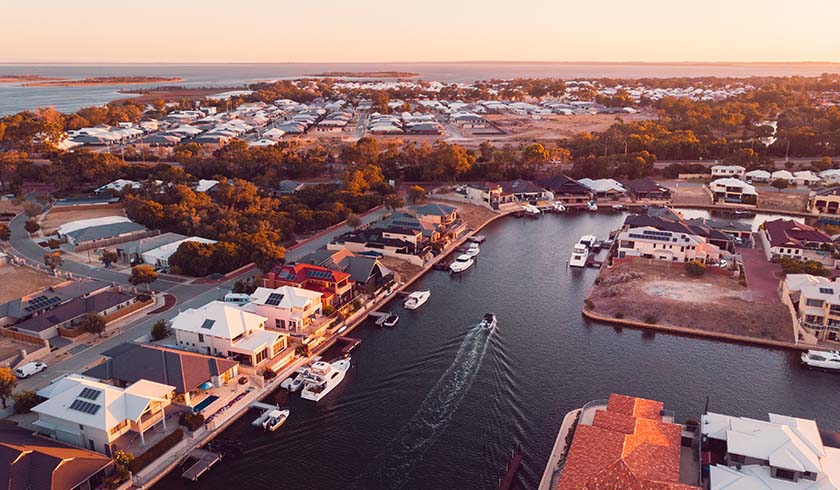10 areas where property prices are falling
New research has identified the top 10 areas recording the greatest change in dwelling market values from 31 March to 31 May.

Eliza Owen, head of research Australia at CoreLogic, has delved into property value declines that have occurred since the onset of the coronavirus pandemic.
“So far, property value declines have been fairly mild. Nationally, the May home value index results show that the dwelling market declined just 0.4 per cent over the month, and preliminary indicators for June are showing the rate of decline has gathered some momentum through the month.
“However, the Australian housing market is not one market, but a collection of many. Over the past few months, dwelling market performance has varied by region, in both a cyclical and structural way,” Ms Owen explained.
The top 10 markets seeing the biggest property price falls are:
- Mandurah (WA): -2.2 per cent
- Greater Melbourne Melbourne - Inner South: -2.2 per cent
- Greater Melbourne Melbourne - Inner: -1.8 per cent
- Greater Melbourne Melbourne - Inner East:-1.8 per cent
- Greater Perth Perth - South East: -1.2 per cent
- Greater Melbourne Melbourne - Outer East: -1.2 per cent
- Greater Brisbane Ipswich: -0.8 per cent
- Greater Sydney Sydney - North Sydney and Hornsby: -0.7 per cent
- Greater Sydney Sydney - Inner West: -0.7 per cent
- Greater Sydney Sydney - Northern Beaches: -0.7 per cent
“Unsurprisingly, Melbourne’s inner city and eastern suburbs have seen the largest decline across the metropolitan region, and the past two months have seen a decline in values across some high end markets in Sydney, such as North Sydney, the Inner West and the Northern Beaches,” Ms Owen said.
“Perhaps more surprising is the continued decline in Mandurah, which had the largest slip in dwelling market values over the past two months. Mandurah dwelling values were 38 per cent below their 2006 peak at the end of May this year. The renewed downwards pressure comes just after the Perth dwelling market was starting to enjoy a long-awaited growth phase in the start of 2020.
“Payroll data analysis from the ABS suggests that payroll job losses across Mandurah has been 6.0 per cent between mid-March and the end of May. This is not especially severe when it comes to job loss across Perth regions, nor would Mandurah have been particularly susceptible to a demand shock from a decline in overseas migration. However, the decline in dwelling values is off the back of a longer-term downward trend, suggesting demand conditions were already fragile across the region.
“The Perth - South East region on the other hand, where dwelling values have slipped -1.2 per cent between March and May, has recently been almost entirely dependent on net overseas migration for new housing demand. ABS regional population growth data for 2018-19 suggests internal migration over the year was negative, compared with about 4,500 net overseas migration arrivals.
“International border closures in response to COVID-19 may have created a significant demand shock, which had interrupted a recovery in the Perth - South East region. Prior to this, dwelling values in the area had seen four consecutive months of growth between December 2019 and March 2020.”
Ms Owen noted at a suburb level, the biggest price falls are more reflective of the historic cyclical trends, “where the downturn is most prevalent in the high end of Sydney and Melbourne this far”.
“At this stage, sound analysis of the change in suburb-level dwelling markets is limited to areas where there are relatively high sales observations.
“It appears that Malvern East, in the Melbourne metropolitan, has been the worst suburb-level performer between the end of March and the end of May across the capital cities, with total dwelling market values down -4.8 per cent. Other relatively steep value falls have been seen across the Melbourne suburbs of Glen Iris (-3.8 per cent), Northcote (-3.5 per cent), Port Melbourne (-3.2 per cent) and Brunswick East (-3.1 per cent).
“Across Sydney, the biggest suburb-level falls in dwelling values had occurred across Mosman (-2.5 per cent), Lane Cove North (-2.4 per cent), Manly (-2.3 per cent), Leichhardt (-1.7 per cent) and Wentworth Point (-1.4 per cent).”
In conclusion, Ms Owen said as the downturn progresses, we are likely to see continued declines in inner-city markets that had previously relied on international migration for new housing demand.
“However, as the wider economic downturn drags on housing demand, mild price declines are likely to spread, resulting in a more broad-based downturn in the next 12 months,” she added.
